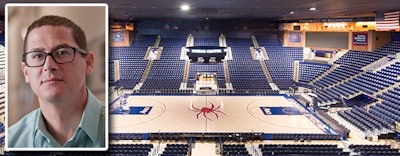
Noting that Knight Commission on Intercollegiate Athletics reports and other research often fail to address issues of facility use and the fan experience, stadium and venue design firm AECOM, in collaboration with Ohio University's Center for Sports Administration, released in August results of the inaugural Trends in Collegiate Athletics survey.
Responses from 136 athletic directors in all three NCAA divisions found, not surprisingly, that 95 percent of ADs are concerned about funding. Eight in 10 plan on making significant facility investments over the next five years, including one in five who plan to spend more than $50 million — with a focus on such fan-experience priorities as connectivity, food and beverage options and premium seating. Senior Editor Paul Steinbach asked Jon Niemuth, AECOM's director of sports for the Americas, for his reaction to the results.
Q: Were you surprised by the percentage of ADs looking to make facility investments?
A: I'm not surprised, because one of the predictions that I've been talking about for several years is that we were going to see a pretty dramatic increase in facility spending commensurate with the decrease of public subsidy funding. I felt like we were going to see this kind of dramatic explosion in investment, as state support is reduced, and institutions are left to their own devices or are required to be more self-reliant for bottom-line operating revenue. Student fees, activity fees and state general funds are often prohibited from being directed toward athletic facilities, so ADs are turning to stadium additions or arena renovations that will produce revenue or generate significant private donations. They have to be almost entrepreneurial.
Q: What does $50 million buy these days?
A: A pretty decent renovation-expansion of a stadium or arena. We have a couple small Division I schools where we're doing either a new stadium or a new arena in that $50 million range. You can do a student-athlete academic counseling center, a nutrition center or a practice facility for football or basketball, which right now will run anywhere between $15 million and $25 million. So, depending on what their needs or program issues are, they may be doing a couple of things for that $50 million.
Q: You found that locker rooms and training facilities are seen as the most important recruiting tools, followed by academic, housing and dining facilities. Is investment still driven by one-upmanship?
A: Alabama and Oregon are probably the two that get the most attention because of some of the things they've done that are quite frankly both really beautiful and pretty extreme. But there's a balance of people who say they want the locker room to be really nice, because that's where the young men or women are going to spend a lot of their time, but not too nice. Meanwhile, the weight room's a weight room, and the academic center is a study hall, and the dining room is where you eat. They're more reasonable about the level of finish in those spaces. Even some of our bigger clients are defining themselves as nice, but not too nice: "It's not who we are. It's not our culture." So they're using it as a little bit of a rallying cry to define their brand and identity.
Q: Is connectivity considered the must-have venue amenity today?
A: It's top of mind for a lot of people — how they can increase their distributed-antenna cell service or WiFi service in general. But I think the next big thing as it relates to that is capacity. We've got folks who maybe put WiFi into buildings two to three years ago who are going to find that the capacity needs to be expanded. So that's where people smarter than me will say, "How do you upgrade a WiFi system to double the capacity once you've put it in there? How do you manage the content that's coming and going to capture revenue?" A lot of folks, even today, see WiFi as a subcost — almost like sidewalks. "I have to have a sidewalk, but it doesn't generate me any revenue. I don't want to spend that much money on it." But led by the professional leagues, there are a couple of universities that are taking a very forward-looking approach to digital media rights, digital ticketing, interaction with social media for promotion. That was one of the other points that came out of the survey: How many folks are seeing social media as a legitimate tool to increase attendance or increase fan loyalty and engagement. And I think what we're probably going to see is how people take a WiFi investment, which could be anywhere from $5 million to $10 million, and actually have that become a revenue-generating component as opposed to "I have to make sure I have enough bathrooms so there aren't long lines."

































